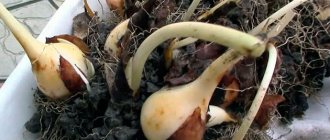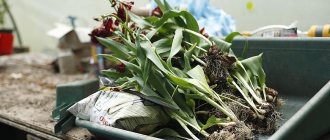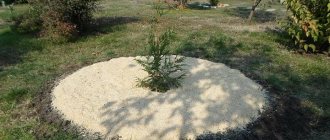Tulips are very beautiful and delicate flowers, symbolizing the beginning of spring. These spring plants serve as decoration for homes, cottages, garden plantations, city flower beds and parks. The tulip belongs to the Liliaceae family and is a bulbous perennial plant. The plant reaches an average height of 10 cm, its stem is straight, and most classes and varieties produce only one bud.
To date, breeders have developed varieties that produce three or more flowers. It is worth noting that tulips have a very diverse color; they can be crimson, white, yellow, burgundy, purple and even black. These flowers have a fairly short flowering period. Many people are interested in the question - what to do with tulips after they have bloomed, how to care for them further?
Tulips are beautiful
Features of growing tulips
The homeland of these magnificent flowers is Asia, where spring comes early, followed by hot summers, often very dry. Plants are adapted precisely to this cycle: awakening at the beginning of spring, then a new growing season, then a state of dormancy.
If you want to see a flower bed in bloom, then you should support this life cycle of fragile flowers:
- After flowering in the spring, you need to wait until all the petals fall off.
- Then the stems should be removed, preventing the seed pod from ripening.
- The last step is digging up the bulbs and storing them until planting.
Immediately after flowering
No matter how much you would like to admire tulips until the very, very last petal, you don’t need to do this. The problem is that after the flower begins to fade and gradually lose its petals, a seed pod will begin to ripen on it. It will use all the strength that the tulip still has after flowering, and the plant will take the nutrients necessary for the ripening of the seeds from the bulb.
As a result, the bulb will weaken significantly and will not be able to properly prepare for winter. You may have come across tulip bulbs that you can “press” with your fingers - it seems like they are empty inside. These are exactly the bulbs that contributed their strength to the ripening of seeds.
There is a very high probability that after this, the bulbs stored for storage will simply dry out and will not germinate in the future. A healthy bulb will always be strong, golden and smooth, without spots, ulcers or bumps. An empty bulb is the first sign of poor planting material.
Therefore, rule one: a tulip flower, no matter how beautiful it may be, must be removed as soon as it begins to lose its petals, without waiting for it to completely wither. Carefully cut or simply tear off the flower without touching the stem and leaves.
The second rule for tulip lovers is that the stems that remain sticking out of the flowerbed after losing their decorative effect cannot be touched. It is with the help of the above-ground part of the plant that the nutrients accumulated there will be supplied to the bulb throughout June and July as the stem and leaves wilt.
These substances are vital for the bulb to ripen and prepare for a long, cold winter. If the plant is deprived of this opportunity, the bulb may simply not survive the frost.
If you are irritated by the gradually darkening and drying parts of the plant, which are clearly visible against the background of green grass, they need to be masked. This is not difficult to do - bright annuals such as nasturtiums or petunias are perfect for this purpose; with their curly shoots and beautiful flowers they will draw attention to themselves and hide the ugly parts of the tulip.
If you planted tulips in tree trunks, you can simply leave the grass growing there alone - you can mow it in July, when the ground part of the tulips has completely dried out. The same applies to group plantings of bulbous plants on the lawn - just leave islands of uncut grass for a while, which will perfectly hide the drying stems from your eyes.
If tulips grow in a rock garden, they are perfectly masked by gypsophila and ground cover plants, which begin to grow just when the spring bulbs have finished flowering. Small bright flowers look wonderful and distract attention to themselves.
Secrets of caring for bulbous bulbs
There is not a single person who would indifferently walk past a blooming flowerbed with tulips, especially if there is a whole dance of these noble flowers in the flowerbed.
But tulips do not always bloom so wildly. They may not bloom the next year or may not bloom as profusely. These pampered plants require special attention. Flower growers need to know the secrets of caring for delicate plantings.
The first thing that worries flower growers is whether they need to cut off the leaves after the tulips have bloomed. After the picturesque picture, the yellowed leaves and faded buds really take on a completely unattractive appearance.
What to do with the leaves? There is no need to rush into pruning, because nutrients are supplied to the bulbs through the foliage. You must be prepared for the fact that caring for these plants will take about 2-3 weeks. And so that faded tulips do not spoil the appearance of the flowerbed, plant perennials between them. These can be long-blooming phloxes.
Leave the leaves and stems after yellowing, otherwise the process of bulb formation will stop. Experts advise not to cut them, but to tear them off with your hands. Why is this being done? If the leaves come off poorly, it means the bulb is not yet ripe. Wait until the leaf is easily pulled out of the ground.
If you remove the foliage prematurely, then next year you may not wait for the lush opening of the buds due to poor ripening of the bulbs.
But the seed pods need to be trimmed. The remaining seed pods will draw energy and nutrients from the bulbs, weakening them so that they will not be able to release a flower stalk.
They are removed after the petals have completely withered and fallen off. This happens 5-8 days after the bud opens. It all depends on the type of flowers.
If you really like the variety, cut off the flower heads 7-8 days after the start of flowering. Try not to let them fall off. What to do with them? You can plant it in the ground, but you will have to wait 5 years for flowering in open ground, so these flowers are bred by dividing those bulbs that form in the ground.
Another trick for flower growers: so as not to lose the place where they were located after the tulips dry, put a beautiful flag.
Tulips have faded, what to do next in the open ground
Immediately after the tulips have bloomed, they continue to be cared for. The end of flowering does not mean that the flowers no longer need moisture and nutrition. In the next 2-3 weeks, the bulbs will accumulate the nutrients they need for normal wintering and increase in size. You still need to do:
- Weeding. Weeds are aggressive and grow rapidly; they deprive crops of essential moisture and valuable minerals. And without weeding, a flowerbed takes on a completely neglected appearance.
- Watering. The soil moisture regime in the flowerbed depends on the current weather. Over the next 2 weeks, watering should be regular in the absence of rain. Once the leaves wither, there will be no need for irrigation.
- Feeding at this time is needed not by the stems and leaves, but by the nascent bulbs. After flowering, tulips are fed once.
It is imperative to carry out the listed activities - this is the key to good preservation of the bulbs in winter and further abundant flowering.
What to do with flower stalks and leaves of tulips
When talking about care, it means that you only need to leave the leaves until they turn yellow and dry naturally. To speed up the process, you can bend the leaves to the ground. In order not to lose flowers in the flowerbed after the leaves die, it is better to make notes in advance in the places where the tulips grow.
The peduncle must be cut off as soon as flowering is completed. This need is due to the fact that during the flowering period, young bulbs that need nutrition are born underground. After the flower stalks are removed, the nutrients will be used for the education and development of the children.
What to do with tulips in pots?
The facade of the house, decorated with flowers in a pot, looks very beautiful. Recently, this hobby has become especially popular. What to do with the plant after wilting:
- You also need to water until the stems completely dry out.
- After waiting for the bulb to go into a dormant state, it must be dug up.
- Then dry it, put it in a dry box, and store it until September. You can wrap it in paper and transfer it to the lower section of the refrigerator.
- In September, plant together with the rest of the bulbous plants.
If you take care of bulbous plants from early spring to late autumn, they will definitely delight you with their beauty.
When tulips bloom
For tulips intended for growing in a park or garden, the active flowering period begins in the second half of April and lasts until May. Many people grow flowers for the purpose of further sale, so you can see tulips on store shelves throughout the year.
Growing for sale
With the onset of spring, florists begin to create amazing bouquets using these flowers. Using various technologies for growing flowers in a greenhouse, you can achieve early flowering of tulips, but the optimal period for flowering plants is still mid-spring.
How to avoid mistakes with digging
Some gardeners are convinced that tulip bulbs will overwinter well in the ground. This is a fundamentally wrong decision. The question: whether to dig up bulbs for storage requires an immediate answer. Bulbs require annual digging and here's why.
An undug bulb will sink lower into the ground every year. In order for it to germinate next year, it needs a lot of strength and nutrients. Also, from one bulb, several more appear in the nest. They are so crowded in a dense nest that it is difficult for them to grow to the surface.
Several years will pass and the tulip growing in one place will lose its varietal properties. The buds will become small, weakened, and will no longer delight with lush flowering. Even worse, he could die.
If you don’t want to lose varietal flowers, you should definitely dig them up. Regular tulips can be transplanted into bulb pots.
Do I need to dig up tulip bulbs after they bloom?
The answer to the question whether it is necessary to remove tulip bulbs from the ground after flowering cannot be unambiguous. It all depends on which tulips were planted on the site:
- Unpretentious old varieties of tulips can grow in one place without digging up to 5-7 years. At the same time, if you dig them up and replant them before this time, you can get better and more abundant flowering.
- Foster, Kaufman, Greig tulips are dug up every 3-5 years.
- Late varieties and Darwin hybrids need to be dug up after 2 years.
- Dutch hybrids are removed from the soil and replanted annually. These flowers are the most capricious.
What happens if you don’t dig up tulip bulbs in the right time? Plants will completely lose their varietal characteristics. The terryness, waviness, and fringe of the petals will disappear. Tulips may not bloom at all.
This is due to the fact that varietal plants need high temperatures to set flower buds. For most species, this figure is +23-25° C. Fringed varieties require a temperature not lower than +25-27° C. At the planting depth, the soil cannot warm up to such temperatures, so the formation of flower buds does not occur.
Another reason why tulips need to be replanted is that over time the bulbs go deeper. In this case, it becomes increasingly difficult for the sprouts to break through to the surface in the spring, and the bulbs themselves in the deep layers of the soil begin to rot. The culture also requires periodic separation of nests.
Each mother bulb over time acquires many children. In cramped conditions you can hardly wait for quality tulip blooms. After being removed from the ground, the nests are disassembled, separating large bulbs from small ones, while simultaneously discarding the planting material. The bulbs are then planted in different places. Large ones are used for growing flowering plants, children and small bulbs are planted in a separate flower bed for growing. Substandard planting material will have to be thrown away.
They begin to dig up the bulbs after the leaves have completely dried. For this work you will need a shovel or a pitchfork. Subsequently, the planting material is stored for a month at a temperature of +23-25° C, then the temperature regime is changed, reducing the indicator to +18-20° C. The bulbs should be kept in such conditions until planting.
On a note! Before digging the bulbs, you need to make sure they are ripe. To do this, dig up one bulb and inspect it. It should be covered with dense brown scales.
How to care after digging
When to dig? Digging is usually carried out before the end of July. It is during this period that the tulips dry out.
But here, too, not everything is so simple. You need to dig a little and find a few bulbs. If a brown husk has formed on them, then they are fully ripe.
After you are sure that the bulbs are ripe, dig them up without mixing up the varieties.
Make the shovel deeper so as not to touch the roots. Shake the bulbs off the ground and place them on a flat surface for inspection. Remove spoiled seeds and immerse healthy ones in a weak solution of potassium permanganate. Leave it there for 20 minutes and then lay it out again to dry. Potassium permanganate will destroy pathogenic spores.
When and how to prune faded tulips
As soon as you notice that the tulips are dropping their petals, you can begin to remove the flower stalks. During this period, flowers rather spoil the appearance of the flowerbed than decorate it and, moreover, spend their energy on ripening the seeds. It is necessary to cut flowering stems with a sharp knife, having previously disinfected them with any of the following antiseptics:
- vodka,
- alcohol,
- potassium permanganate solution.
This is necessary to protect the wound from infection.
On a note! If tulips are grown for cutting, it is customary not to cut them with a knife, but to break them off at the base, leaving two leaves on each bulb to provide nutrition.
Do I need to divide the onions?
This process must be carried out in any case. How to separate onions? Small ones grow around the large nodule, which must be separated. If it’s a pity to throw them away, then dry them, and in September plant them in boxes with nutritious soil. Perhaps at home they will produce strong shoots by spring.
If you manage to grow plants from small nodules, transplant them into open ground in the spring. True, no one can guarantee that the variety you wanted to grow will survive.
Planting should be done only when the ground warms above 10 degrees Celsius. Many gardeners plant as seedlings when the ground warms up enough and frost will not return. In this case, the seedlings can be transferred to a permanent place.
When to dig up tulips
Depending on the climate, the weather, cool or hot, the period for digging up tulips is determined. Another parameter is the variety of bulbous. The early variety is dug up earlier, the late variety later. Signs that will help determine the right time for these actions:
- the leaves of the plant turned yellow and lay on the ground;
- the tulip stem is not yet dry, it bends but does not break;
- the integumentary scales of ripe bulbs should be brown.
When harvested very early, the bulbs and children remain underdeveloped, and the decorative value of future flowers is reduced. But if you wait until the shoots dry completely, you can get seed material infected with a fungus, with damaged protective scales.
Regional factor
In warm climates, all agricultural work begins earlier than in cold climates. Obviously, the bulb extraction period extends from June 15 to early August, depending on the region of the country:
- in May - early June, this operation begins in the southern regions of Russia;
- mid-late June - in the middle zone;
- in July - in the Urals and the north of European territory;
- the first days of August - in Siberia.
How to dig and store bulbs
The day you choose to dig up your tulips will determine how well the bulbs will last. That's why it's better to keep it warm and dry. A pitchfork or shovel will help you, and the procedure is:
- dig a little further from the flower so as not to damage the bulb and roots;
- shake off all the soil, separate the bulbs and examine them;
- throw away everything rotten or with defects;
- Treat the bulbs with a fungicide if there is fungus, spots, spots. These are signs of disease. Store such bulbs separately;
- If you dig up tulips in the rain, wash the bulbs and dry them in a warm, ventilated room.
After drying, after about two days, the bulbous nests easily fall apart. Once again, clean them of husks and dead roots and neutralize them in a 0.5% solution of potassium permanganate. This will nourish the bulb with microelements and destroy rot pathogens. After the next drying, sort the bulbs by size and place them in one layer in open boxes.
Important! A stable temperature when storing the bulbs, without sudden changes, is the key to future beautiful flowers. During storage, buds are formed, leaf blades and peduncles are laid. A week before planting tulips, the storage temperature in the room should not exceed 15-17°.
Having left the tubers for storage, do not forget about them before planting. Regular inspection will help preserve the material. Gray rot and fusarium often spoil lying bulbs. If the lesion is small, the rot can be cut off with a knife, the onion can be pickled, sprinkled with ash and dried.
How to store tulip nodules
How to preserve the bulbs of these delicate plants before planting in the ground:
- First, the onions are placed under a canopy for ventilation. It should be warm and dry there.
- After a few days, you can remove the stuck soil; there is no need to peel off the skin.
- Leave to dry for another 20 days.
- If the material has not been sorted, then it’s time to start sorting. Place the largest ones separately.
- At the same time, sort by variety.
- Place the bulbs in special boxes with a bottom that is well ventilated. This way you will protect the material from rot.
- Review the planting material from time to time. You won't have to store it for long, but even during this time it may deteriorate.
Plant large-caliber material separately, and medium-caliber material separately. Thanks to this division, the bed will remain in bloom for a long time, because flowering of different sizes of material will occur at different times.
Digging up bulbs and preparing for storage
By the end of June - the first half of July, the stems dry out completely. For those who decided to dig up tulips after flowering, now is the time to do it.
Scheme "Life cycle of tulips"
Many gardeners argue about how often they should remove bulbs from the soil. An important argument is the creation of a favorable temperature regime for the varietal properties of the future tulip. Temperatures in the range of 23–25⁰ above zero are essential for the bulbs for the next two months. On the territory of the Russian Federation, the soil is not capable of warming up to such an extent. Therefore, the relevance of the annual digging of tulip bulbs on the face.
Another important reason for such a useful procedure is the disappearance of varietal characteristics and the reduction in the ability to reproduce tulips. It is transplantation that can sort out full-fledged bulbs and reject damaged and diseased ones.
It’s not enough just to know when to dig up tulips after flowering; you need to be able to properly preserve the bulbs for the next season. All bulbs should dry well within a week. A warm, dark and well-ventilated place is well suited for these purposes. After this, selection work begins, namely: all roots and damaged scales are removed. The selection is based on the size of the bulbs. Damaged and diseased specimens are removed.
Before planting, tulips are stored for an average of 2 - 2.5 months. During this period, it is important to create optimal conditions for the formation of a flower bud in the bulb. The temperature ranges from 23–25⁰С above zero, after a month it is reduced to 15–18⁰С above zero and after another month it is brought closer to the maximum natural temperature of 10–12⁰С above zero. The bulbs can be laid out in two layers. You should monitor the condition of the scales. Excessive drying will negatively affect future flowers.
When is the time to plant tulips?
At the end of September or beginning of October, in sunny weather, transplantation into the soil occurs. Before planting, they must be kept in a manganese solution again. Find a new spot in the garden and begin this important work.
How to properly transplant to a flowerbed:
- Make a hole approximately 8 centimeters deep;
- Water generously, plant the bulb, cover with soil;
- A week after the planting procedure, sprinkle the soil with ash and pour in a solution of ammonium nitrate;
- Lay down mulch. You can cover the bed with a thin layer of peat.
Baby tulips: how not to lose
If tulip bulbs remain in the ground for several years, then every year they will become deeper into the soil. This prospect makes it impossible for the bulbs to grow through a huge layer of soil. To avoid such a situation, you should make some preparations in the fall.
When planting tulips, experienced gardeners recommend using special containers with holes in the bottom, which will help limit the growth of the children. And in the summer they can be easily dug up without losing a single bulb.
If you are planting a lot of bulbs in the fall, you can use plastic window screens. To do this, you must first remove the top ball of soil in the flowerbed and dig a pit up to 20 centimeters deep. Afterwards, spread the net (so that its ends are on the surface), add a layer of fertile soil and plant the bulbs at a distance of 5 centimeters from each other. After the end of the flowering period, the net is lifted by all four corners at the same time, without injuring the bulbs.
When to feed tulips
These delicate fragile plants are very demanding when it comes to feeding. Moreover, the flowerbed will have to be fertilized 3 or 4 times per season. First in early spring, as soon as the soil thaws a little. The second time when the buds appear. The third time - for lush flowering. And the fourth - after dropping the petals.
How to fertilize plants: first of all, they need nitrogen. Then they will need phosphorus and potassium. If the leaves begin to die, you should feed them with magnesium. Are the buds setting poorly? Requires calcium fertilizer.
It is best to feed with complex fertilizer Kemira, Universal-2. After watering, many gardeners sprinkle dry fertilizers at the rate of 30 g per 1 square. After the third sheet unfolds, the manipulation should be repeated. For the third feeding, take superphosphate: 20 g per 1 sq.m.
How to prolong the flowering of tulips
Just yesterday the flower garden was ablaze with large, juicy “heads” of tulips. But the beauty of a tulip is fleeting.
You can extend the flowering of tulips over time by selecting varieties.
It’s good if you selected varieties according to flowering time and created a conveyor, then flowering will last for 1-1.5 months. Creating such a flower garden is not easy. Flower growers in tulip parks such as Keukenhof (Netherlands) select varieties with different flowering periods for their plantings. Some are fading, attention to them is decreasing, others are just entering the flowering phase. Different timings prolong the pleasure for tulip lovers.
The photo shows that the middle tulips have already faded, and the late ones are only in buds. They need different care.
Tulips bloom longer if:
- it is cold outside;
- the soil around the bulb is moderately moistened;
- no natural anomalies (hail, snow, gusty wind, extreme heat).
What will grow after tulips
After the bulbs are dug up, there will be an empty space. And it’s only June, there’s a whole summer ahead. What to plant after these flowers? Any seedlings of annual flowers are suitable: asters, purslane, tagetes, ageratum;
- perennials grown from seeds;
- decorative cabbage;
- indoor potted flowers (pelargonium, kala, coleus).
Tulips can be planted near hosta bushes. When the tulips calm down, the hosta will begin to reveal its gorgeous leaves. The foliage of this plant will cover the empty ground without disturbing the beauty of the garden.
Dear friends, there are many recommendations on what to do with tulips after flowering. Take the advice of experienced flower growers and admire the lush flower beds of these magnificent flowers for a long time.
What to plant next to tulips when they bloom
If the flowerbed consists of only tulips, after flowering it looks completely empty. In order for this area to remain decorative, you need to plant other plants here. What crops can be used for this purpose? It is not recommended to plant perennials in a flower bed with tulips.
Perennial plants have a strong, powerful root system that will compete with tulips for food and oppress them. Yes, and digging up the bulbs in this case will be problematic. This means that the choice should be made on annual flowers, but even in this group of plants, not every plant is suitable for planting together with tulips.
Moisture-loving and fast-growing plants (for example, marigolds, nasturtiums) are not very good neighbors. They require abundant watering, in which case the tulip bulbs may rot in the ground.
But there are still many plants that will decorate a flower bed without damaging the tulips. This:
- New Belgian aster;
- swing paniculata;
- subulate phloxes;
- pelargonium;
- marigold;
- toadflax;
- godetia;
- Iberis;
- nigella;
- salvia;
- ageratum.
The listed plants are unpretentious, even if you disturb their roots when digging up tulip bulbs, the flowers will not get sick, much less die. You can contemplate a constantly blooming flowerbed if you plant plants according to the principle of a designer. Using this technology, tulip bulbs are planted in the ground in advance in a special plastic basket.
After the flowers have withered, the container is removed from the ground, and in its place another container with plants ready to bloom is placed. The basket with tulips is transferred to the shade and they wait for the leaves to completely wither, after which the bulbs are removed and prepared for autumn planting. This method may seem labor-intensive to some, but with this approach the garden will always look well-groomed and bright.
Digging and storing bulbs
In order to know everything about tulips, the rules of planting and caring for them, first of all you need to understand what planting material is best suited for planting. You can buy the bulbs, or you can harvest them yourself. If you decide to prepare planting material on your own, then after the tulip has flowered you need to very carefully, trying not to damage it, dig up the most developed flowers and carefully examine the bulbs. A healthy bulb has a dense texture, it is smooth and slightly shiny. Such specimens are placed in a container in one layer and ventilated for several days in the fresh air. Then, the container is moved to a place where the temperature is kept at +22°C. After two weeks, the bulbs are cleared of crust and soil and stored until planting (late September-October) at a temperature of +15...+17°C.











